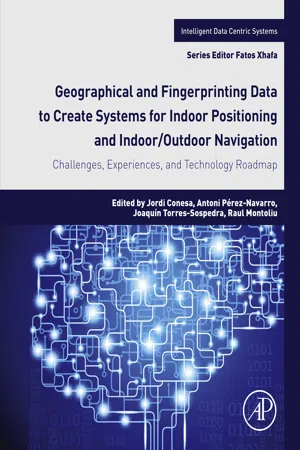
Geographical and Fingerprinting Data for Positioning and Navigation Systems
Challenges, Experiences and Technology Roadmap
- 403 pages
- English
- ePUB (mobile friendly)
- Available on iOS & Android
Geographical and Fingerprinting Data for Positioning and Navigation Systems
Challenges, Experiences and Technology Roadmap
About This Book
Geographical and Fingerprinting Data for Positioning and Navigation Systems: Challenges, Experiences and Technology Roadmap explores the state-of-the -art software tools and innovative strategies to provide better understanding of positioning and navigation in indoor environments using fingerprinting techniques. The book provides the different problems and challenges of indoor positioning and navigation services and shows how fingerprinting can be used to address such necessities. This advanced publication provides the useful references educational institutions, industry, academic researchers, professionals, developers and practitioners need to apply, evaluate and reproduce this book's contributions.
The readers will learn how to apply the necessary infrastructure to provide fingerprinting services and scalable environments to deal with fingerprint data.
- Provides the current state of fingerprinting for indoor positioning and navigation, along with its challenges and achievements
- Presents solutions for using WIFI signals to position and navigate in indoor environments
- Covers solutions for using the magnetic field to position and navigate in indoor environments
- Contains solutions of a modular positioning system as a solution for seamless positioning
- Analyzes geographical and fingerprint data in order to provide indoor/outdoor location and navigation systems
Frequently asked questions
Information
Challenges of Fingerprinting in Indoor Positioning and Navigation
† Internet Interdisciplinary Institute (IN3), Castelldefels, Spain
‡ Institute of New Imaging Technologies, Jaume I University, Castellón, Spain
§ Faculty of Applied Engineering, University of Antwerp—IMEC IDLab, Antwerp, Belgium
¶ Department of Information Engineering, Electronics and Telecommunications (DIET), Sapienza University of Rome, Rome, Italy
|| Department of Computer Science, University of Cyprus, Nicosia, Cyprus
** Trilogis srl, Rovereto, Italy
†† Intelligent Vehicles and Traffic Technologies Group, University of Alcalá, Madrid, Spain
‡‡ HFT Stuttgart, University of Applied Sciences, Stuttgart, Germany
§§ Laboratory of Electronics and Communications Engineering, Tampere University of Technology, Tampere, Finland
¶¶ Department of Multimedia and Information-Communication Technologies, University of Zilina, žilina, Slovakia
|| Algoritmi Research Center, University of Minho, Guimarães, Portugal
*** Samsung R&D Poland, Warszawa, Poland
Abstract
Keywords
1 Motivation
2 Indoor Positioning Systems
2.1 Position, Location, and Navigation
Table of contents
- Cover image
- Title page
- Table of Contents
- Copyright
- Dedicatories
- Contributors
- Preface
- Acknowledgments
- 1: Challenges of Fingerprinting in Indoor Positioning and Navigation
- 2: Wi-Fi Tracking Threatens Users’ Privacy in Fingerprinting Techniques
- 3: Lessons Learned in Generating Ground Truth for Indoor Positioning Systems Based on Wi-Fi Fingerprinting
- 4: Radio Maps for Fingerprinting in Indoor Positioning
- 5: Crowdsourced Indoor Mapping
- 6: Radio Fingerprinting-Based Indoor Localization: Overcoming Practical Challenges
- 7: Low-Complexity Offline and Online Strategies for Wi-Fi Fingerprinting Indoor Positioning Systems
- 8: Study and Evaluation of Selected RSSI-Based Positioning Algorithms
- 9: Mapping Indoor Environments: Challenges Related to the Cartographic Representation and Routes
- 10: OGC IndoorGML: A Standard Approach for Indoor Maps
- 11: The EvAAL Evaluation Framework and the IPIN Competitions
- 12: IndoorLoc Platform: A Web Tool to Support the Comparison of Indoor Positioning Systems
- 13: Challenges and Solutions in Received Signal Strength-Based Seamless Positioning
- 14: Deployment of a Passive Localization System for Occupancy Services in a Lecture Building
- 15: Remote Monitoring for Safety of Workers in Industrial Plants: Learned Lessons Beyond Technical Issues
- 16: A Review of Indoor Localization Methods Based on Inertial Sensors
- 17: Fundamentals of Airborne Acoustic Positioning Systems
- 18: Indoor Positioning System Based on PSD Sensor
- Index